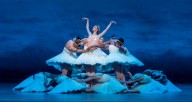The first time I saw the Joffrey Ballet perform, I remember physically attending the Auditorium Theatre in Chicago and being struck by the decadence, the halls and aisles paved in scarlet, velvet and gold. I remember wanting to both cross my legs and fly. A feeling of royalty came across me as the curtains opened, the opulence set the tone for the excellence to come and I knew I would be enchanted by a Chicago unknown.
The evergreen Joffrey Ballet gave a spectacular premiere of “Under the Trees’ Voices” Friday, screened via Joffrey’s website and dedicated to French choreographer (and Joffrey rehearsal director) Nicolas Blanc’s grandfather, Hubert Chassain. It was nothing short of that Auditorium awe I felt seeing the company in person. Fluid, cinematic motion fell captive to the romantic developments before us and afforded me angles that an orchestra seat couldn’t top.
Inspired largely by a walk near Lake Michigan while listening to Italian Composer Ezio Bosso’s “Symphony No. 2,” Blanc noticed nuanced perk in people’s spirits as COVID restrictions began to ease in the summer of 2020. Similarly to the pandemic, Blanc saw the musical composition as a powerful journey and he was inspired to set it to movement.
The opening scene began in silence, with dancer Xavier Nunez peeling over on the ground underneath larger-than-life gold leaves expended in the air. Like chimes or wired mobiles, structural leaves designed by Jack Mehler twinkled in the lights overhead. Following the dancer’s kinesthetic exploration of the ground and in his body, these dramatic gestures rippled to the remaining dancers staggered on stage. As the invisible string section began to play the Bosso piece, we were transcended into scenes with rigorous ballet technique that swept across the stage and through the screen. Ballerinas flirted with levels, graduating from lengthy lunges to eventually landing on pointe, bourréeing swiftly between one another, navigating a delicate balance of both rest and action. The entire performance was all leaps and bounds, with Bosso’s romantic orchestral recording accentuating even the simplest gestures like a flexed hand, or a brush over the shoulder. I saw worlds in their movements, in part because Joffrey is comprised of dancers that represent an impressive 13 countries (Spain, Brazil, Mexico, South Korea and Canada, to name a few) — arboles, cherry blossoms, a weeping willow — a symbolic reminder to stand tall when nature calls us to, but to also find beauty in seeking refuge and stillness. I wanted to take a trip to the lake after, but I settled for my nearby community garden.
Lush partnering and moody solos heightened the performance in the scenes that followed. The excitement for me was in the contrasts between floorwork and pointe, duets against a chorus, solos against partnering. In the third section, Christine Rocas performs a somber solo while she witnesses a rigorous partnership in her peripheral vision. She is eventually joined by two additional couples; sometimes, they serve as an extension of her grace. At other points, they complement her grief and simplicity with hope of love in their dreamy lifts and smooth entanglements.
The premiere concludes with a high-spirited concerted number to Bosso’s quick-tempoed final movement, boasting the full breadth of the dance ensemble and orchestra. For just over half an hour, “Under the Trees’ Voices” will help you forget the woes of the world and transport you into your favorite childhood fairytale, where you smiled at the bat of eyelashes, or got lost in song. Adulthood has helped me forget what fairytales could be used for in real life. If you’re like Blanc, you too will be moved by Bosso’s “Symphony No. 2”. Perhaps you will clean your home to it or use it to put your baby to bed. Perhaps you will ensure that all young people experience Joffrey’s dreamy worlds. Or maybe, your imagination will blow like peony petals and you will arrive softened with the belief that anything is indeed possible, as a Wicker Park banner says, “in Chicago, as it is on earth.”


